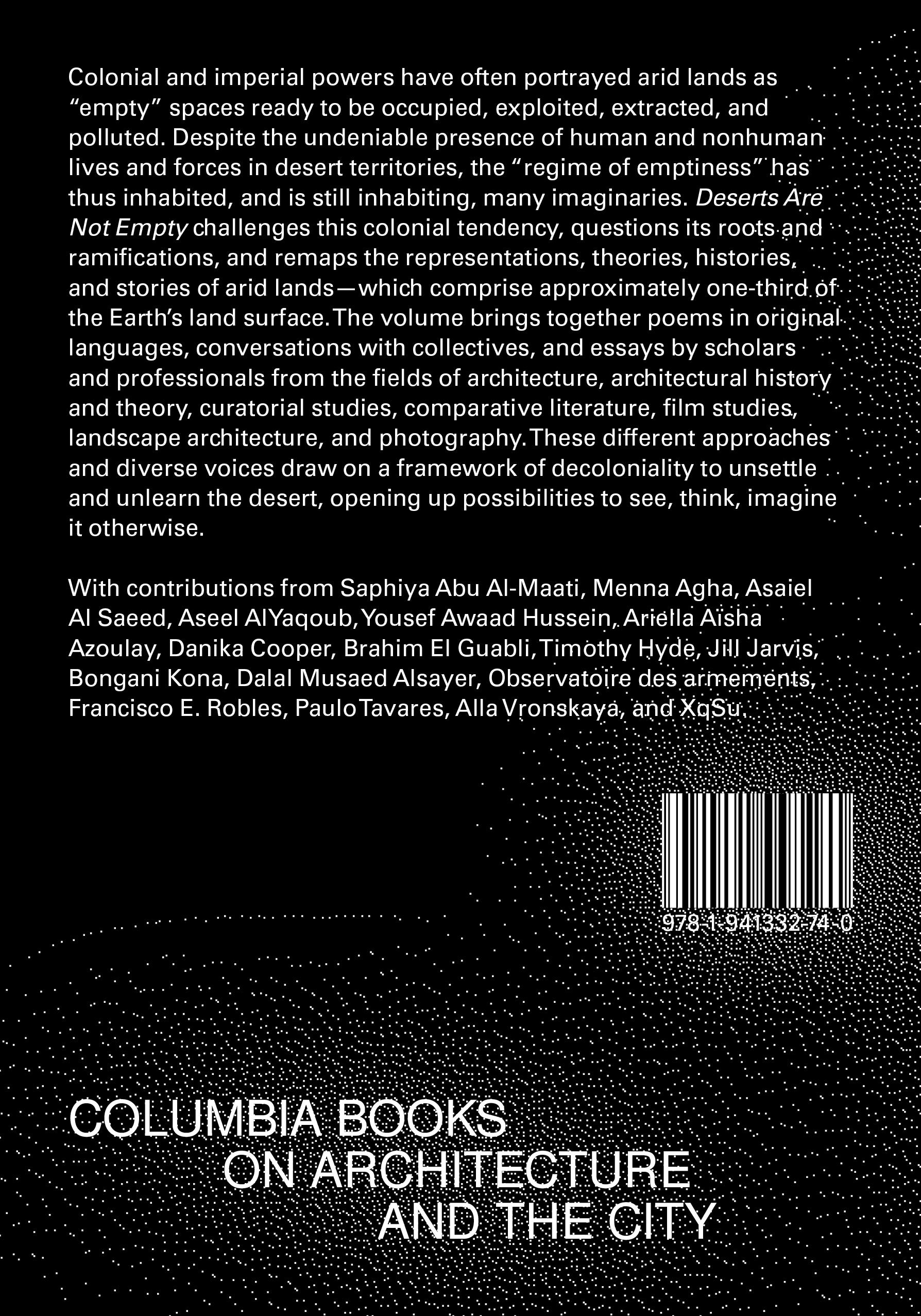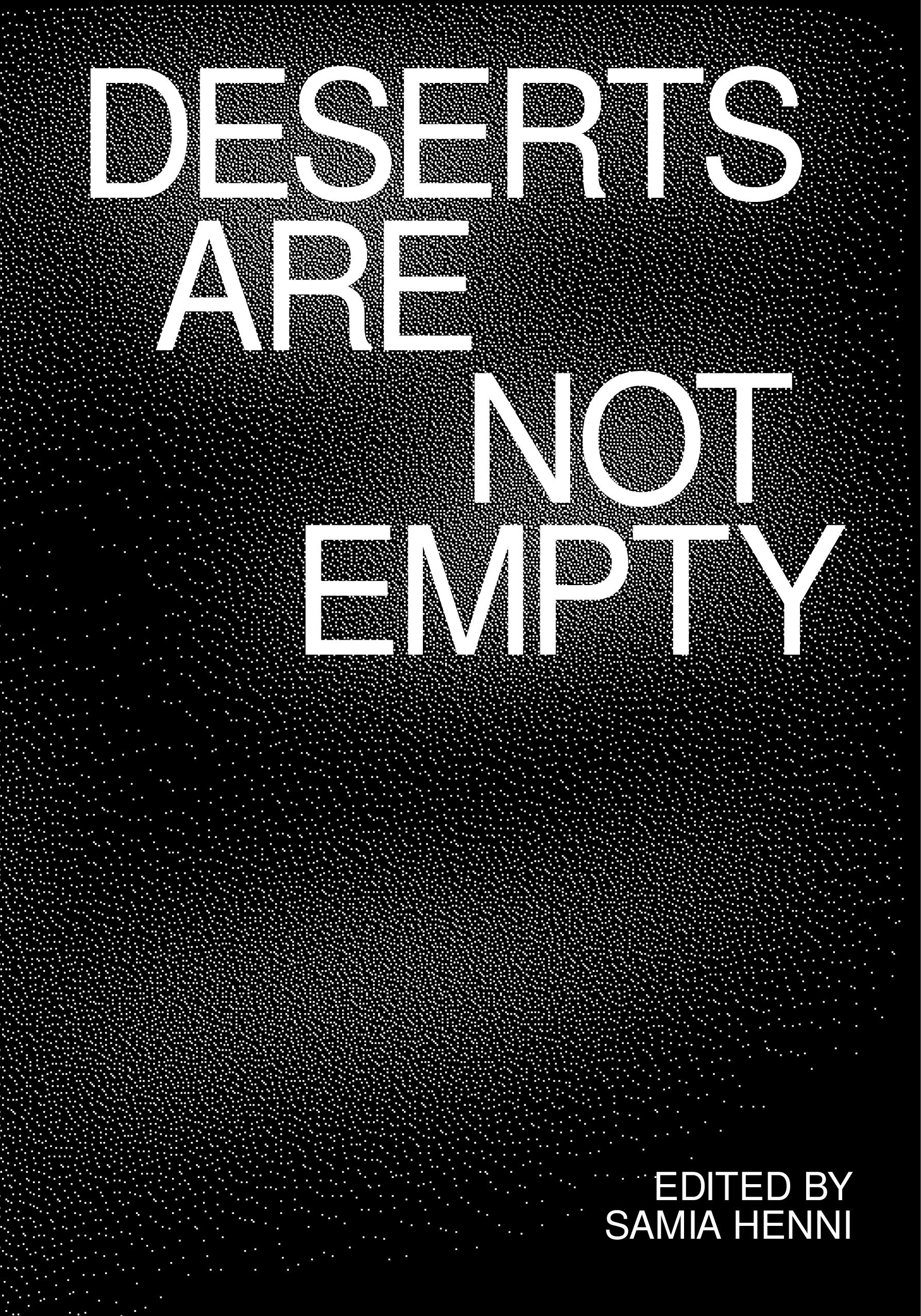AGAINST THE REGIME OF “EMPTINESS”
The term “desert” stands in for a complex locus of imageries, imaginaries, climates, landscapes, spaces, and histories. The territories of both hot and cold deserts embody various forms of anthropogenic exploitation, such as colonial dispossession, resource extraction, and civil and military occupation. And yet, among the most common platitudes about the desert are ideas that “deserts are empty,” that “the desert is absent of life,” or that “there is nothing at all in the desert.” This misleading conceptualization of the desert has served to legitimize its transformation, manipulation, toxification, and destruction. This stereotype was, for instance, the justification offered by the French army to defend its choice to use the Algerian Sahara—then a French colonized territory—as the firing field for France’s first atomic bombs between 1960 and 1966. According to General Charles Ailleret, the head of France’s nuclear program, the Sahara was “a land of thirst and fear, from which all life was reputedly absent,” the designated desert characterized by “the total absence of animal and vegetal lives.”1
1 Charles Ailleret, L’aventure atomique française: Comment naquit la force de frappe. Souvenirs et réflexions (Paris: Editions Bernard Grasset, 1968), 229. Translated by the author. [“Pays de la soife et de la peur, d’où toute vie était réputée absente dans les espaces immenses qui séparent Reggane de Tessalit.”]
Against the Regime of “Emptiness” 11
2
Contrary to this imaginary, the Sahara is not devoid of life. Desert territories—which comprise approximately one-third of the Earth’s land surface—host human, nonhuman, biological, microbiological lives. They support sedentary, nomadic, animal, vegetal, mineral forms of existence. Even though the presence of life in desert territories might seem evident, to this day, one is repeatedly hearing and reading the same old colonial platitudes. This is because industrialized subjectivities and exploitative authorities are constantly searching for and in need of so-called “empty” places to be “filled” through occupation, extraction, mining, production, and accumulation. These mechanisms are often intertwined with implicit or explicit forms of coloniality and toxicity, which result in racializing, altering, damaging, or destroying the living, natural, and built environments present in the desert.
Deserts Are Not Empty is concerned with these processes of anthropogenic construction and destruction that have occurred in various deserts over the last century. This book does not offer comprehensive histories of affective and romantic approaches to the desert, nor does it deal with artistic, literary, philosophical, and theological theories of the desert.2 Instead, it seeks to scrutinize and comprehend the deeds and practices of modern nation-states, corporations, and institutions—both civil and military—and the harm they cause by “filling” desert territories, spaces, and atmospheres. It is interested in undoing the ramifica tions of colonial projects in the desert and unfolding the politics of representation, extraction, forced displacement, infrastructure, and “desertification” narratives.3
The essays and conversations that constitute Deserts Are Not Empty question the dynamics of coloniality and toxicity both environmental and sociopolitical. Introduced by sociologist Aníbal Quijano in the 1990s, the concept-term coloniality can be defined as a process of domination and dispossession, which began with the devastation of the Americas in 1492 and continues to this day. Such extractive and destructive practices have been
See, for example, Elizabeth A. Povinelli, Geontologies: A Requiem to Late Liberalism (Durham, NC: Duke University Press, 2016); Lyle Massey and James Nisbet, eds., The Invention of the American Desert: Art, Land, and the Politics of Environment (Berkeley: University of California Press, 2021); David Jasper, The Sacred Desert: Religion, Literature, Art, and Culture (Malden, MA: Blackwell Publishing, 2004); Aidan Tynan, The Desert in Modern Literature and Philosophy: Wasteland Aesthetics (Edinburgh: Edinburgh University Press, 2020); Reyner Banham, Scenes in America Deserta (Cambridge, MA: MIT Press, 1989).
3 On desertification, see, for example, Diana K. Davis, “Desert ‘Wastes’ of the Maghreb: Desertification Narratives in French Colonial Environmental History of North Africa,” Cultural Geographies 11, no. 4 (October 2004): 359–387.
particularly reinforced over the course of the Cold War and the Nuclear Age, as well as with the continuous rise of right-wing nationalists around the world. According to Quijano, one of the fundamental principles of coloniality “is the social classification of the world’s population around the idea of race, a mental construction that expresses the basic experience of colonial domination and pervades the more important dimensions of global power.”4 Nomadic, semi-nomadic, and nonnomadic populations living in deserts, fallaciously deemed “empty,” have been, and still are, racialized—continuously subjugated to the violent racial and racist dynamics that underpin colonial conceptualizations of the desert. Their lands, too, were, and in many cases still are, occupied, exploited, and heavily damaged.5
On the other hand, the production of toxicity is embedded in processes of colonialization and mechanisms of coloniality. 6 The structures that allow lives, soils, matters, and atmospheres to be polluted and toxified are based on colonial land conditions, which serve colonial projects, military rivalries, industrial goals, and economic incentives. These conditions include occupation, expropriation, dispossession, and in some cases massacres. In desert territories, they operate through the search for and extraction and transportation of natural resources, such as oil, gas, and lithium, as well as via the construction of company towns, infrastructures, and energy, climate, aerospace, chemical weapons, and atomic weapons research centers. Under the banner of “emptiness,” and the inanity that “there is nothing at all in the desert,” those living in occupied deserts have been forcibly displaced, denomadized, and in some cases exterminated—either immediately or gradually. As environmental critic Rob Nixon argues in his book Slow Violence and the Environmentalism of the Poor, maintaining media attention on the temporalities of toxicity is challenging: “not only because it is spectacle deficient, but also because the fallout’s impact may range from the cellular to the transnational and (depending on the specific character of the chemical or radiological hazard) may stretch beyond the horizon of imaginable time.”7 In addition to struggling to imagine,
4
Anibal Quijano, “Coloniality of Power, Eurocentrism, and Latin America,” Nepantla: Views from South 1, no. 3 (September 2000): 533.
6
5
See, for example, Nick Estes, Our History Is the Future: Standing Rock versus the Dakota Access Pipeline, and the Long Tradition of Indigenous Resistance (London: Verso, 2019).
On this relationship, see, for example, Max Liboiron, Pollution Is Colonialism (Durham, NC: Duke University Press, 2021).
7 Rob Nixon, Slow Violence and the Environmentalism of the Poor (Cambridge, MA: Harvard University Press, 2011), 47.
Against the Regime of “Emptiness”12 Samia Henni 13
measure, and capture the temporalities of harm imposed on the desert and its population, the lack of attention is also triggered by the absence, scarcity, and classification of resources.
However, as a way to imagine “the horizon of imaginable time” of both the coloniality and toxicity that haunt desert populations, territories, and beyond, it is worth returning to the specific case of France’s nuclear program in the colonized Algerian desert. Between February 1960—about five years after the outbreak of the Algerian Revolution, or the Algerian War of Independence (1954–1962), and four years after the first exploitation of Algerian oil—and February 1966, France designed and built two military bases in the Algerian Sahara: the Centre Saharien d’expérimentations militaires (CSEM, or Saharan Center for Military Experiments), built for 10,000 workers in Reggane in the Tanezrouft Plain, approximately 1,150 kilometers south of Algiers; and the Centre d’expérimentations militaires des Oasis (CEMO, or the Center of Military Tests of Oasis), designed for 2,000 people in Ecker, about 600 kilometers southeast of Reggane.8 Despite Algeria’s referendum on self-determination, which was approved by 75 percent of voters on January 8, 1961, and its independence after 132 years of French colonial rule in March 1962, France detonated seventeen nuclear bombs and tested other nuclear technologies and weapons.9 These atmospheric bombs and underground atomic explosions caused irreversible contamination, spreading radioactive fallout across Algeria, Central and West Africa, and the Mediterranean (including southern Europe).10
To secretly prepare for and execute its first atomic bomb, the French army demarcated an area of about 100,000 square kilometers around Reggane. It erected a base-vie (life base) called Reggane-Plateau to house civil and military personnel, with underground laboratories and workshops; an advanced
8 Bruno Barrillot, Les irradiés de la république: les victimes des essais nucléaires français prennent la parole (Brussels: Editions GRIP, 2003), 19–23.
9 In 1966, France moved its nuclear weapons testing from Algeria to another territory under French rule: the Mururoa and Fangataufa atolls in colonized Tahiti Nui (French Polynesia) in the southern Pacific Ocean. Despite objections and protests, the French colonial authorities conducted nearly 200 atmospheric and underground nuclear experiments there between 1966 and 1996, further toxifying colonized environments.
10 For an overview of these atomic bombs, see, for example, Samia Henni, “Toxic Imprints of Bleu, Blanc, Rouge: France’s Nuclear Bombs in the Algerian Sahara,” in “Toxic Atmospheres,” special issue, The Funambulist 14 (November–December 2017): 28–33.
11 Barrillot, Les irradiés de la république, 19–20. France Ministry of Defense, Rapport sur les essais nucléaires français (1960–1996), vol. 1, La genèse de l’organisation et les expérimentations au Sahara (CSEM et CEMO), classified report (1998), 57–71, http://www.obsarm.org/essais-nucleaires.pdf.
base named Hamoudia; and ground zero zones where the bombs would be detonated.11 After approximately two-and-a-half years of design and construction in the desert, most of the construc tions planned for the CSEM in the colonized Algerian Sahara were completed, comprising 82,000 square meters of buildings, 7,000 square meters of underground works, 100 kilometers of roads, 1,200 cubic meters of water per day, 4,400 kilovolts of power in three power plants, more than 200 kilometers of under ground cables and pipes, and 7,000 cubic meters of reinforced concrete in the ground zero zones.12 On February 13, 1960, the first atomic bomb—codenamed Gerboise bleue (Blue Jerboa) after a tiny jumping desert rodent—was successfully detonated. The bomb had a blast capacity of about 60 to 70 kilotons, roughly four times the strength of Little Boy, which was dropped by the United States on Hiroshima on August 6, 1945, about a month before the end of World War II.13 Additional bombs were exploded on the soil of the Sahara until February 1966, which caused a few uncontained atomic “accidents.”14
In 1966, the French army moved its nuclear program to the atolls of Mururoa and Fangataufa, another colonized territory in the southern Pacific Ocean. They dug large holes in the Sahara and buried radioactive remains, engines, equipment, objects, and materials, covering them with contaminated soil and sand. Over the years, the winds and people living in the Sahara uncovered this toxic matter, contaminated debris, and radioactive pieces of architecture.15 Testifying to the scars of the French atomic bombs in the Sahara, a witness published in Bruno Barrillot’s Les irradiés de la république: les victimes des essais nucléaires français prennent la parole (The Irradiated of the Republic: The Victims of the French Nuclear Tests Speak Out), in a chapter titled “Enfouissement des matériels contaminés” (Burying of Contaminated Materials), asserted that “there was no particular medical follow-up of the population around Reggane.”16 The toxicity and coloniality of France’s nuclear program—which severely damaged and contaminated the human, animal, vegetal, and mineral lives of the desert—did not disappear with the departure of the French colonial authorities and with Algerian independence. On the contrary, they are engraved on the
12 Rapport sur les essais nucléaires français, 1:46–47.
13 Ailleret, L’aventure atomique française, 382.
14 On one of these “accidents,” see, for example, Louis Bulidon, Les irradiés de Béryl: L’essai nucléaire français non contrôlé (Paris: Editions Thaddée, 2011).
15 Barrillot, Les irradiés de la république, 43–44.
16 Barrillot, Les irradiés de la république, 43–44. [“Il n’y a pas eu de suivi médical particulier de la population autour de Reggane.”]
Against the Regime of “Emptiness”14 Samia Henni 15
particles of the desert for thousands of years, if not forever. The temporalities of France’s (and other modern nation-states’) coloniality and toxicity in the Sahara (and in other deserts) must be imagined, re-imagined, voiced, presented, and re-presented despite institutional obstacles, including, in the case of France, the classification of the great majority of military archival records of the nuclear program, which are deemed “top-secret military documents.”
Thanks to the extensive work of two independent associ ations of nuclear victims, France’s secrecy was questioned and challenged. The partial lifting of this secrecy occurred with a legal case initiated in 2004 by the associations Moruroa e tatou and AVEN (Association des vétérans des essais nucléaires, or Association of the Veterans of Nuclear Tests) in the context of a complaint against X17 filed with the Health Unit of the Paris Public Prosecutor’s Office.18 Following a favorable response from the French Commission consultative du secret de la défense nationale (Advisory Board on National Defense Secrets) on March 21, 2013, the French Minister of Defense opened access to 154 documents on the nuclear bombs in the Sahara.19 The documents include various charts and tables of air radioactivity records at CSEM and CEMO desert sites. For example, thirty-eight documents titled “radioactivity of the air” and ninety-five documents titled “radioactivity measurements” show only graphs and weekly or monthly reports of air radioactivity at both sites; the great majority of these documents do not contain any comments. The most useful documents, when they are legible, are those that report on air radioactivity after each of the seventeen atmospheric and underground detonations. However, as Barrillot stated, “Certainly, the radiological and biological and other monitoring services have developed more detailed reports, but they are not part of the documents declassified
17 In French, filing “a complaint against X” means that the complaint is lodged against unknown persons.
18 Bruno Barrillot, Essais nucléaires français: à quand une véritable transparence? (Obsarm: February 2014), 1, http://obsarm.org/spip.php?article226.
19 Copies of these documents can be freely consulted at the Observatoire des armements (Centre de documentation et de recherche sur la paix et les conflits) in Lyon, France. See http://obsarm.org.
20 Barrillot, Essais nucléaires français, 2. [“Il est certain que les services de contrôle radiologiques et biologiques et autres ont élaboré des rapports plus circonstanciés mais ils ne font pas partie des documents déclassifiés en mars 2013. On ne dispose donc que d’informations partielles, voire tronquées et difficilement exploitables.”] Barrillot is referring, particularly, to the 129 official reports on the French tests in the Sahara quoted in the confidential defense report La genèse de l’organisation et les expérimentations au Sahara (CSEM et CEMO) of 1998, which were not declassified in March 2013.
in March 2013. This means that only partial or even truncated information is available, which is difficult to use.”20 These sources are not that useful for writing the history of France’s nuclear bombs in colonized Sahara and thereby for making the French government accountable for its harm imposed on the desert and its population.
The institutional obstruction of history-writing and the denial of social and environmental justice are embedded in France’s coloniality and toxicity, as well as in its attempts at delaying and unsettling the “horizon of imaginable time”: the imaginable time and temporality of the medical care of the victims, the decontamination of the sites, the detoxification of the radioactive materials and infrastructure left on site, and the cleaning of the undergrounds and overgrounds of the desert. What happened to the populations living in the desert during and after the fact? Where did those colossal cubic meters of concrete and other construction materials come from? What happened to the toxic matters after their employment? Who is responsible and accountable for social reparation and environmental decontamination? What are the legal devices that existed, or exist today, to impose or reject these colonial conditions? How do colonial built, dismantled, destroyed, displaced, toxified, buried, unearthed, or wasted environments operate within these conditions? How to constitute alternative archives, sources, and evidence to narrate these histories?
These lines of inquiry inform some of the essays and conversations included in this volume. They also guided the 2020 Preston Thomas Memorial Lectures at the Department of Architecture, Cornell University, as well as two conference panels: “Designing in the Desert” at the International Conference of the Society of Architectural Historians in 2020 and “Colonial Spatiality in African Sahara Regions” at an International
21 The Preston Thomas Memorial Lecture Series, “Into the Desert: Questions of Coloniality and Toxicity,” were held online for the Department of Architecture, Cornell University, between October and November 2020. Speakers included: Ariella Aïsha Azoulay, Dalal Musaed Alsayer, Paulo Tavares, Asaiel Al Saeed, Aseel AlYaqoub, Saphiya Abu Al-Maati, Yousef Awaad Hussein, Nadim Samman, Menna Agha, Alessandra Ponte, Solveig Suess, and Zoé Samudzi. See https://aap.cornell.edu/ news-events/desert-questions-coloniality-and-toxicity#open-sec-7. The “Designing in the Deserts” panel included Secil Binboga, Timothy Hyde, Fernando Luis Martinez Nespral, Dalal Musaed Alsayer, and Alla Vronskaya, and convened at the Society of Architectural Historians, 73rd Annual International Conference, Seattle, Washington, April 29–May 3, 2020. The “Colonial Spatiality in African Sahara Regions” panel included Maria Gonzalez Pendas, Enrique Bengochea Tirado, José RodriguezEsteban and D. Barrado-Timón, Violeta Ruano Posada, Gemma Jennings, and Paul Bouet, and met at the International Congress: Colonial and Postcolonial Landscapes: Architecture, Cities and Infrastructure, Lisbon, January 16–18, 2018.
Against the Regime of “Emptiness”16 Samia Henni 17
Congress in Lisbon in 2018.21 The majority of these presentations and papers have critiqued the imposed “regime of emptiness” and demonstrated that research on desert territories requires a variety of sources, including oral history, literature, films, fictions, personal accounts, art projects, and field visits. Deserts Are Not Empty thus also invites readers to challenge their reading habits and reconsider the modalities of and the relationships between and across desert zones as well as between deserts and urban, rural, and other areas, including oceans. It aspires to voice this critique and divulge these methodologies, which are, in many cases, the only plausible way to record desert stories and histories. Some of these accounts evidence how the imaginaries and imageries of “empty” deserts get propagated and carried over time through materials, bodies, institutions, archives, poems, plans, maps, so on, and how they fulfill state and corporate interests in “filling” desert landscapes and their desires to do so.
The aim of scrutinizing state- and corporate-led transformations of deserts is three-fold. It intends first to expose the relationships between architecture and the politics of coloniza tion, wars, forced displacement, ethnic cleansing, representation, and logistics; second, to elicit that the supply of sand, fossil fuels, lithium, and other resources and goods comes from the desert’s underground and overground strata; third, to call for reparation and ask authorities and stakeholders to pay off their debts, their accumulated debts. The scale, space, and time of these rela tionships are multiple, sometimes broken, sometimes illegible, sometimes unimaginable, sometimes incomplete. In “Indent (To Serve the Debt),” a chapter in their book All Incomplete, critical theorists Stefano Harney and Fred Moten argue that:
The impossible and impossible-to-satisfy master is dazzled by it [indebtedness], would open it, wants total access to it, but what they do in the absence of that access, which will have been endured as enclosure, is conceptualize it, place a value on it, impose terms upon it that are meant to approach and explain and regulate the invaluable, the incalculable, while also submitting it to the wasteland of credit, the outer depths of usury, the desert, the slough, the plantation, the prison of the eternally payable.22
In other words, the colonizer, the officer, the exploiter, the administrator, so on, is obsessed with obtaining “total access to” the desert. Given that such totality is not possible, the desert is occupied, militarized, conceptualized, capitalized, transformed, or destroyed. While the “regime of emptiness” imposed on desert populations and territories obeys precisely these dynamics, this volume, Deserts Are Not Empty, interrogates them and stages the “dazzle of indebtedness.”
This book invites readers to subvert the analysis of the conceptualization of the desert. The essays and conversations spatialize economic, environmental, political, social, health, psychological, and military debts. As in the poem Sahara: Visions atomoniques (Sahara: Atomic Visions), in which the Tuareg poet and painter Hawad, originally from the Saharan Aïr Mountains in northern Niger, bears witness to the devastating effects of France’s nuclear bombs in the desert, referencing debt, death, radiated bodies, toxified environments, and (still-) contaminated sand, soil, water, and human and nonhuman lives, the essays and conversations herein remember, testify to, and confront various temporalities of coloniality and toxicity that desert terri tories and populations have been, and are still, facing. Hawad writes:
Agag gag garet!
This is no longer an innocent game hide and seek between nature and denature. Neither is it of three jerboas leaping in spikes of mirages. Blue mirages green mirages purple mirages swallowing six jerboas turned into a rainbow of sulfur and mercury, which consume the resin of their own essence. No, the game exceeds the cynical pretense, the military poetry of enumeration and attribution from reference numbers to jerboas and to hallucinatory pantings of mirages and desert wind.23
22 Stefano Harney and Fred Moten, All Incomplete (Colchester, NY: Minor Compositions, 2021), 83. Against the Regime of “Emptiness”18 Samia Henni 19
The volume echoes—among other reverberations—that architecture is not only what is designed and built but also what is indebted, destroyed, dismantled, contaminated, displaced, buried, unearthed, and wasted. Deserts Are Not Empty insists: “This is no longer an innocent game.”
23 Hawad, Sahara: visions atomiques (Paris: Paris-Méditerranée, 2003), 16–17. Translated by the author.
[Ce n’est plus un jeu innocent de cache-cache entre nature et denature. Pas plus qu’il ne s’agit de trois gerboises bondissant en épis de mirages. Mirages bleus mirages verts mirages violet avalant six gerboises transformés en arc-en-ciel de soufre et de mercure, qui consument la résine de leur propre essence. Non, le jeu dépasse le faux-semblant cynique, la poésie militaire d’énumération et d’attribution de matricules aux gerboises et aux halètements hallucinés des mirages et du vent du désert.]
Acknowledgments
I would like thank Isabelle Kirkham-Lewitt and Joanna Joseph for their tireless reading, careful editing, delightful patience, and esteemed engagement in this collective endeavor.
I would also like to thank all the authors and interlocutors for their determined work and delightful commitment, as well as Andrea Lee Simitch, Meejin Yoon, and the Preston Thomas Memorial Lecture Series Fund at the Department of Architecture, Cornell University, for their generous support.
My gratitude also goes to Patrice Bouveret, the co-founder of the Observatoire des armements in Lyon, France, for agreeing to publish Bruno Barrillot’s photographs and for his hospitality in Lyon, and to Pascal Schwaighofer for his tireless support and intellectual inspiration.
Note on translation
Several authors have been invited to select poems to precede their contributions, which appear both in their original language and in English. The translations and reproductions reflect the various ways the poems are found and shared across communities and formats. Some have been scanned from their original source, some handwritten, and some typed. Unless mentioned otherwise, all translations in the volume are by the authors.
Note on visual evidence
Photographs of the environmental impacts of France’s nuclear weapons program in the Algerian Sahara are included on pages 368–383. These images were taken by Bruno Barrillot, the co-founder of the Observatoire des armements in Lyon, France, during a visit to France’s nuclear sites in Reggane and Ecker in the Algerian Sahara, with the filmmaker Larbi Benchiha and his team in November 2007. Benchiha directed the documentary Vent de sable, Le Sahara des essais nucléaires (Sandstorm, The Sahara of Nuclear Tests), which was released in 2008, and L’Algérie, De Gaulle et la bombe (Algeria, De Gaulle, and the Bomb), which was released in 2010. Other photographs of this environmental colonial disaster can be found in At(h)ome, a film directed by Elisabeth Leuvrey and released in 2013, which documents Bruno Hadjih’s photographs.
Against the Regime of “Emptiness”20 Samia Henni 21
Photographs by Bruno Barrillot, the co-founder of the Observatoire des armements in Lyon, France. The images were taken during a visit to France’s nuclear sites in Reggane and Ecker in the Algerian Sahara, with the filmmaker Larbi Benchiha and his team in November 2007. Courtesy Observatoire des armements (www.obsarm.org).
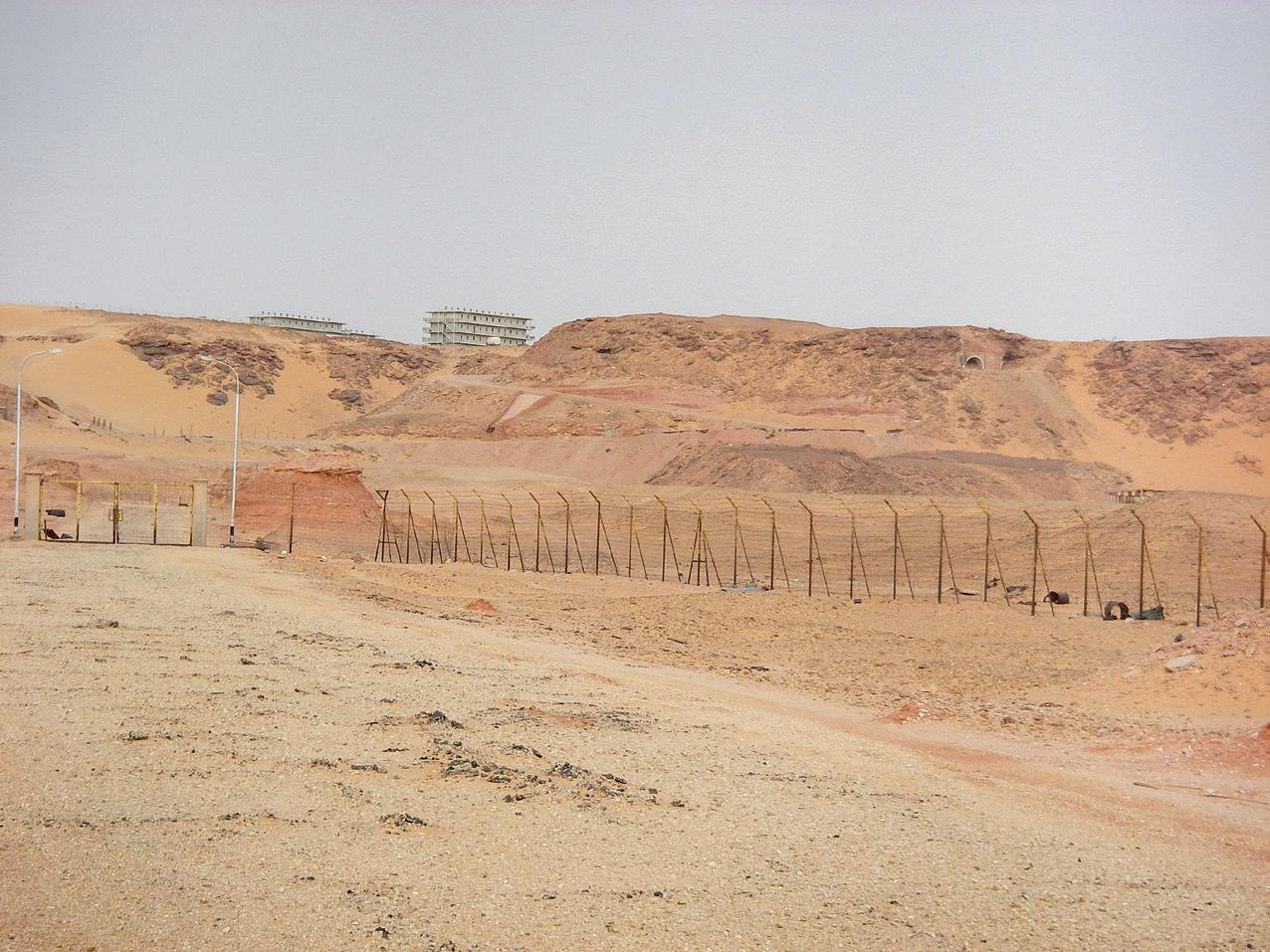
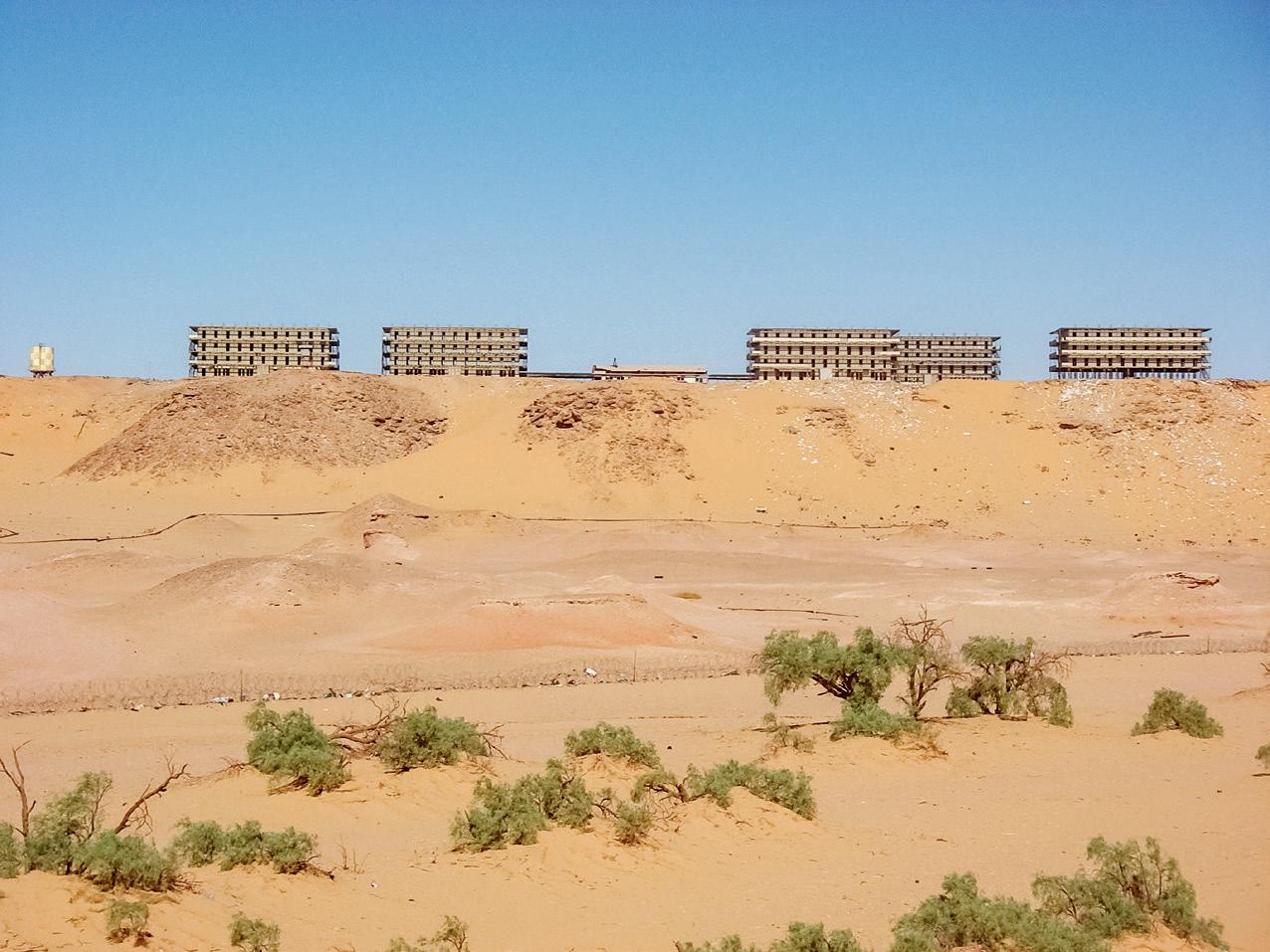
On the context of these nuclear wastes and radioactive landscapes, see the introduction to this book.



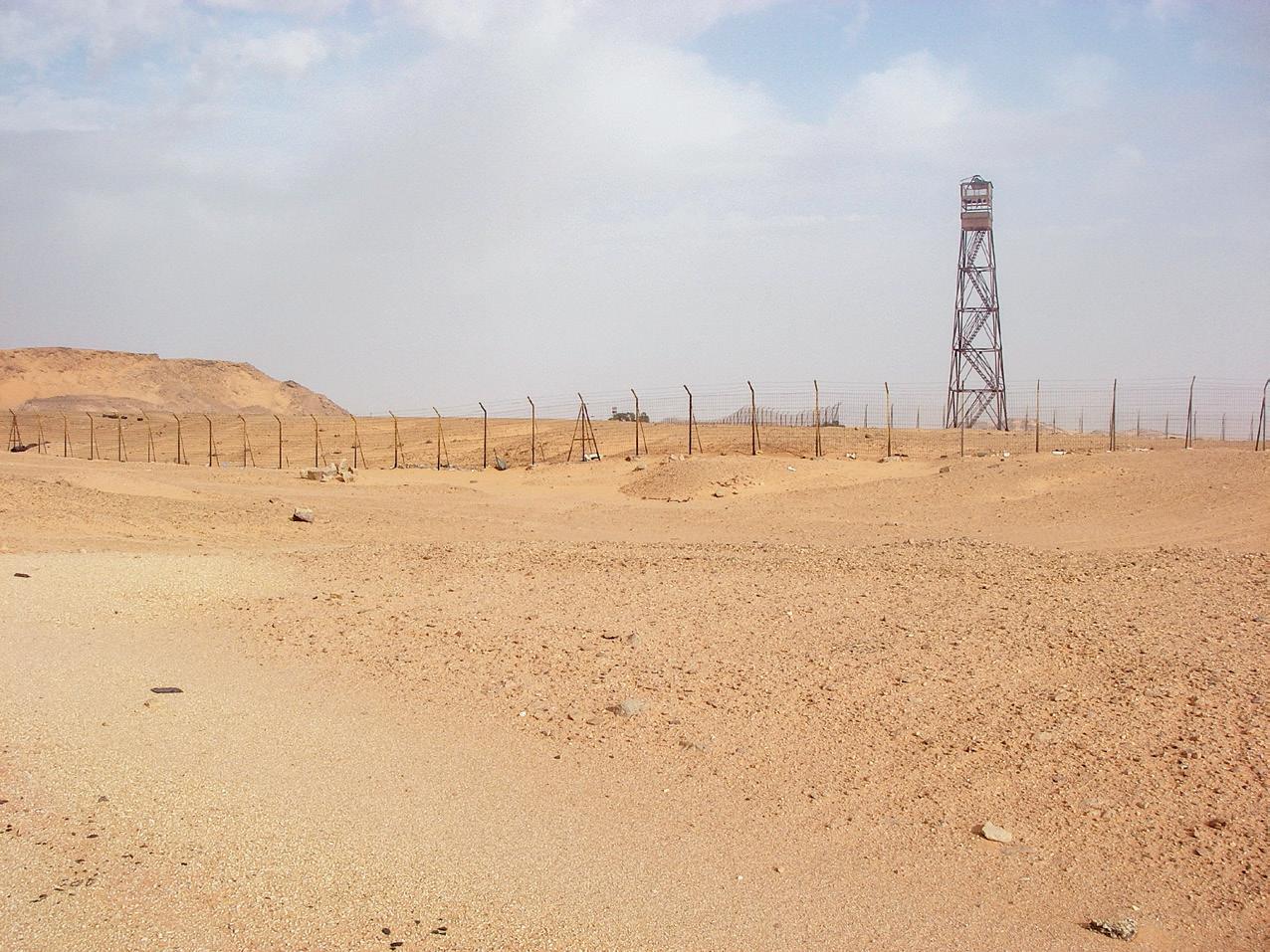

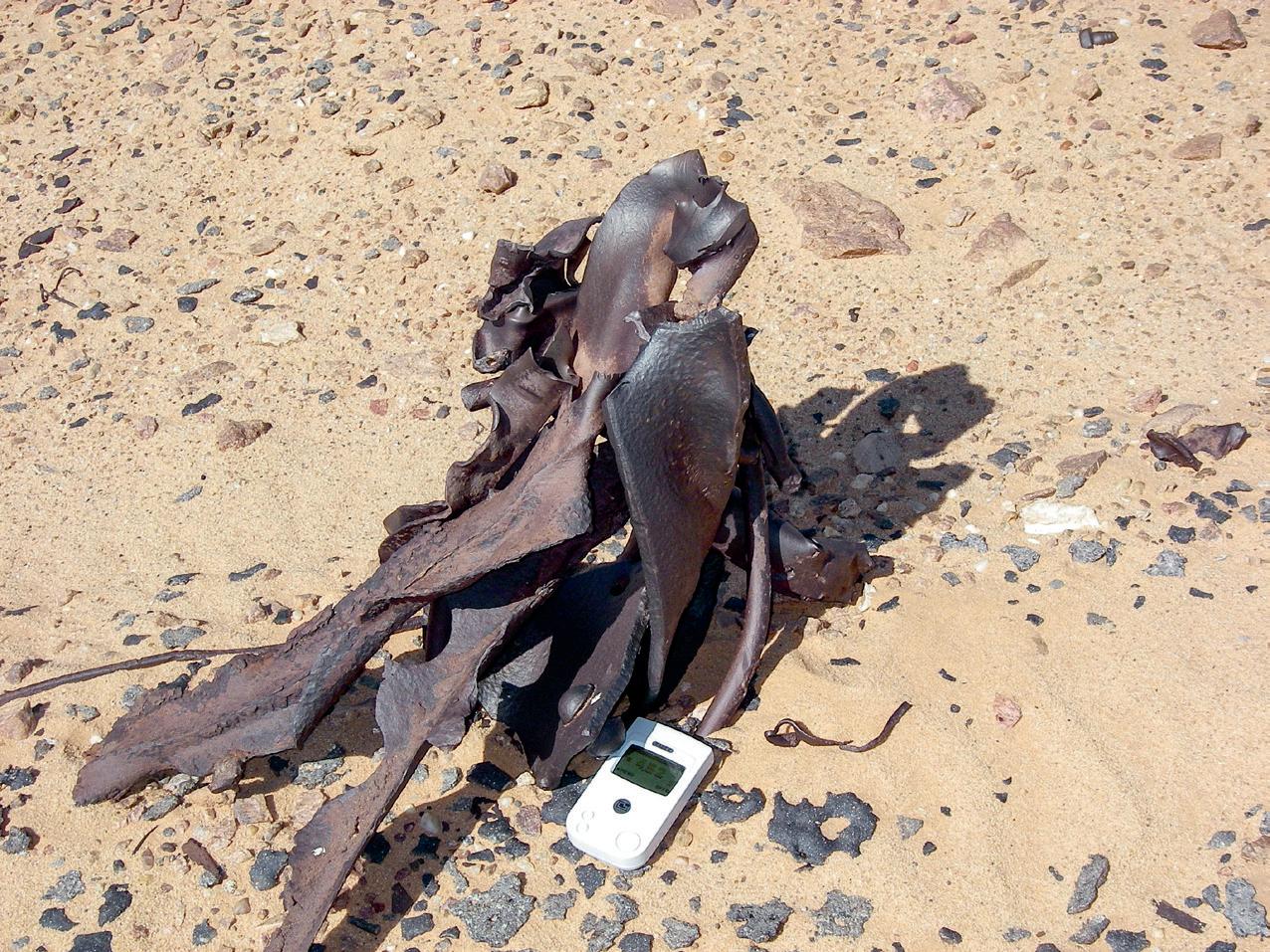
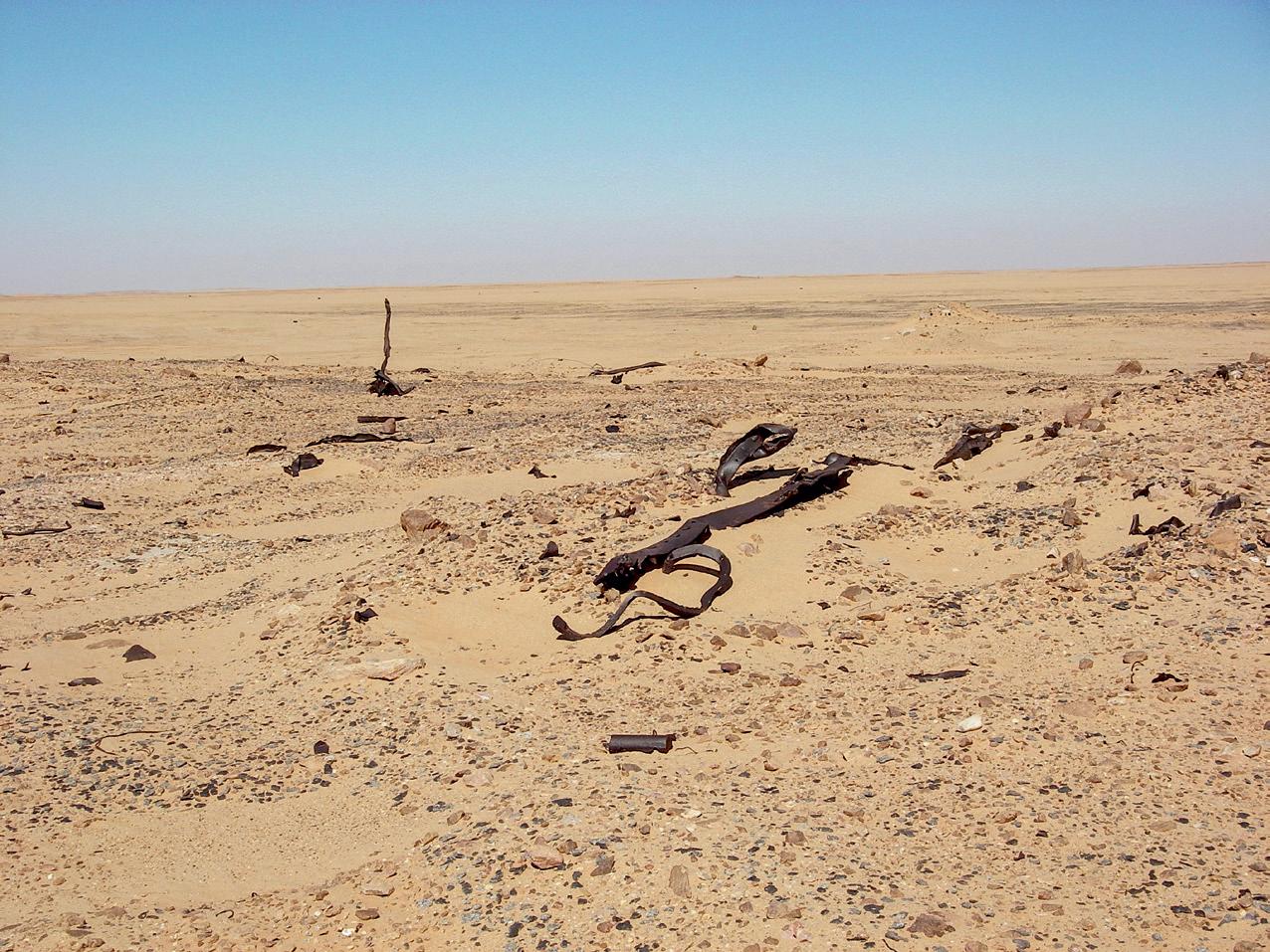


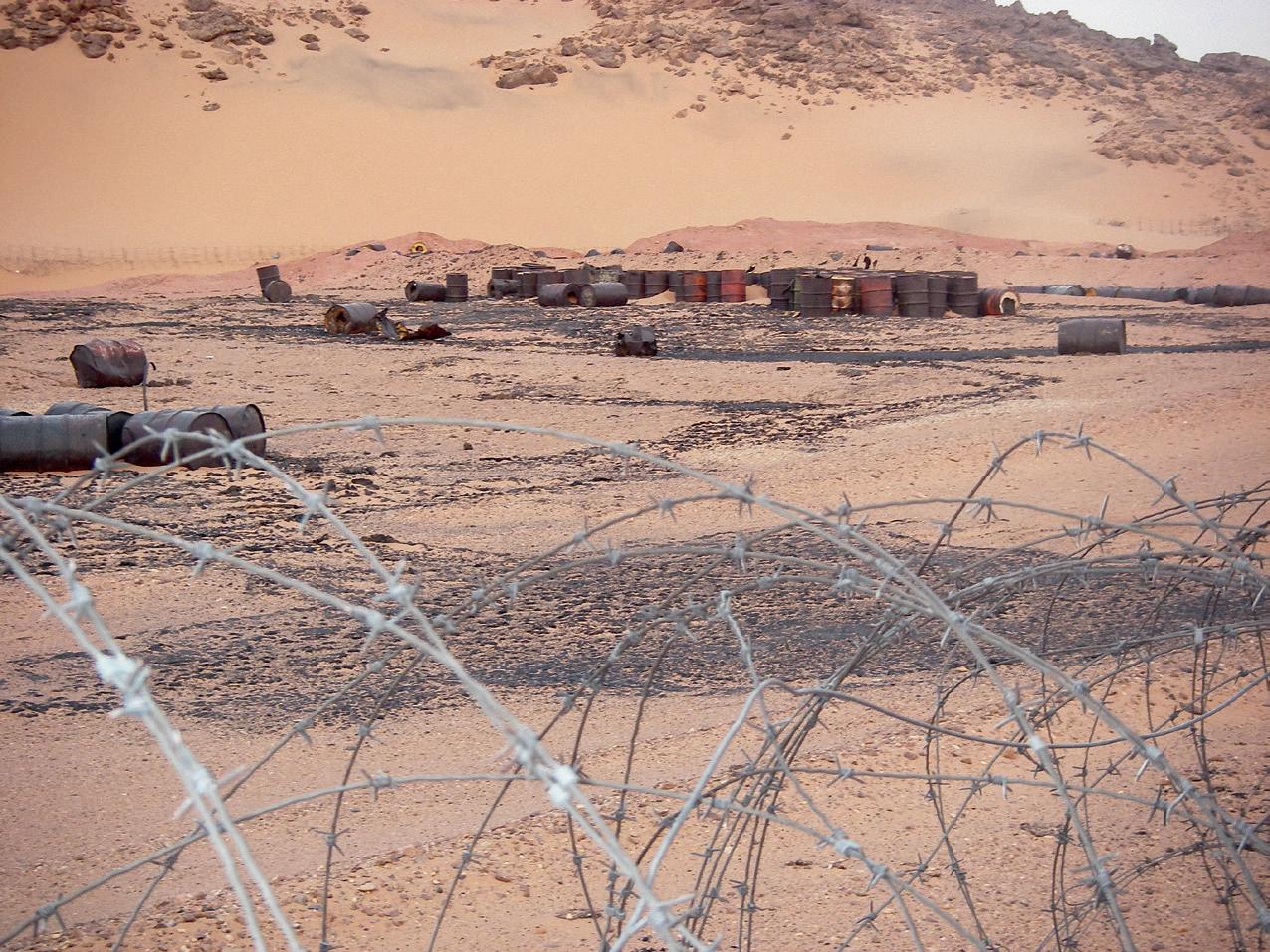

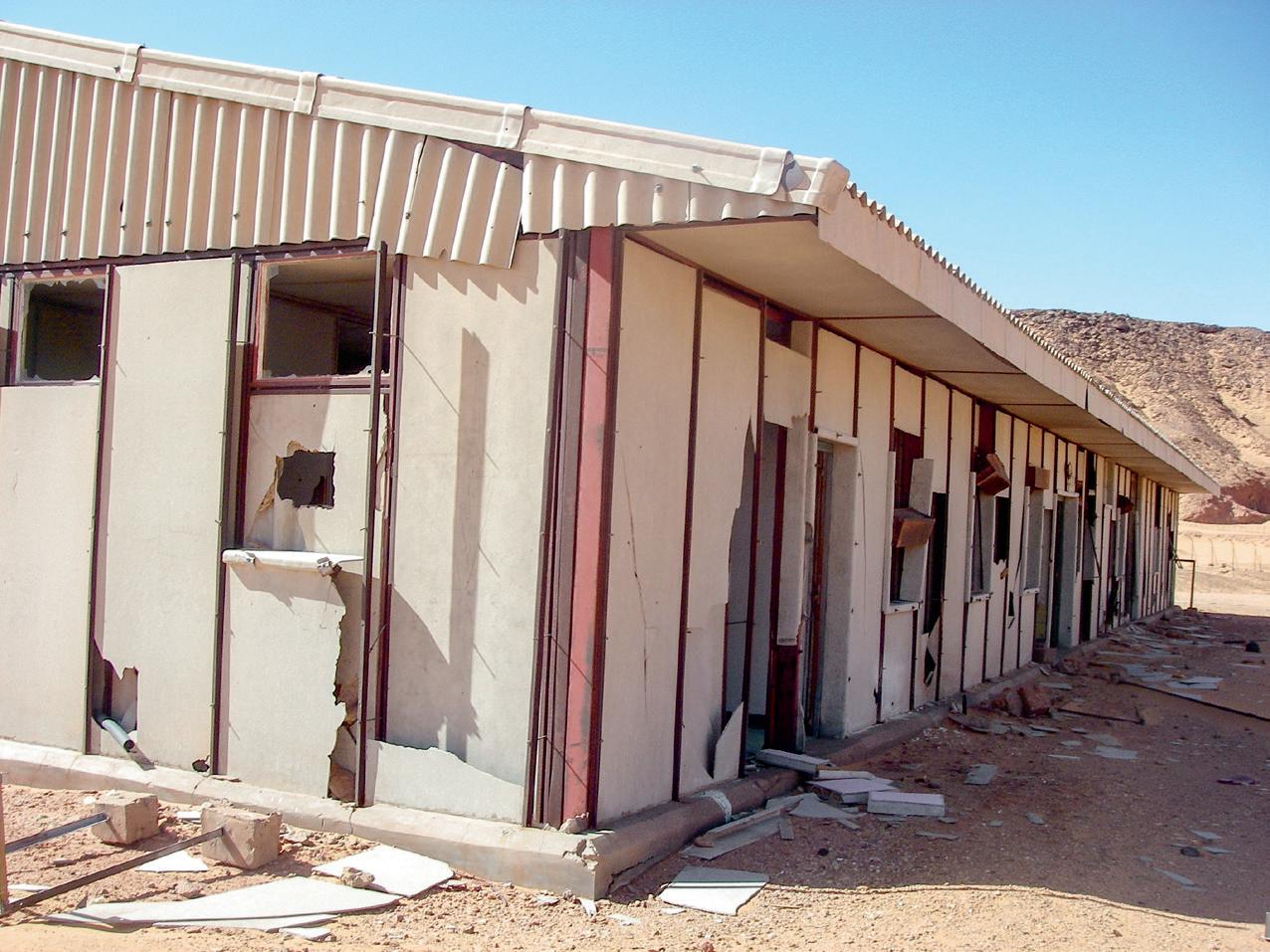
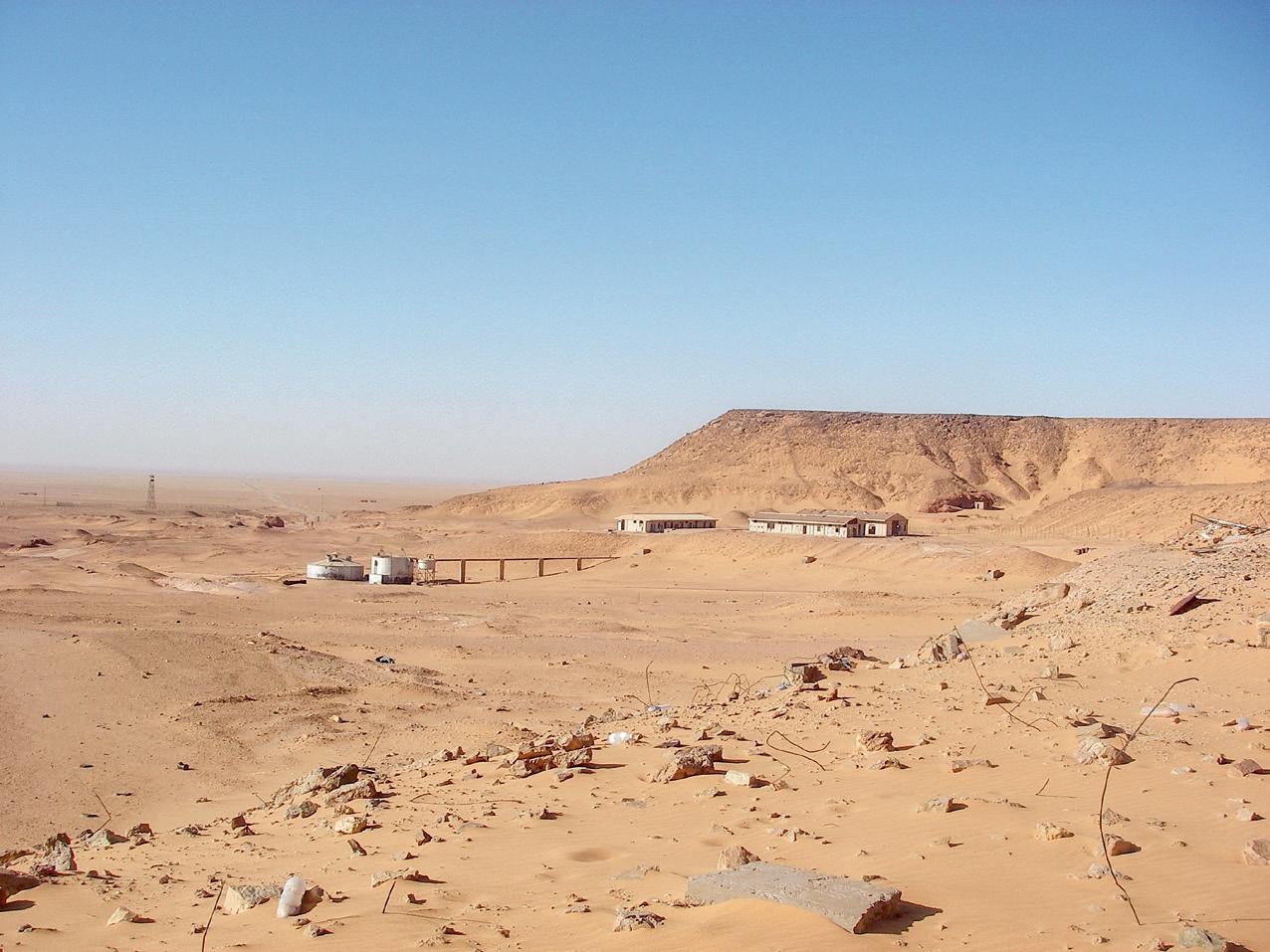

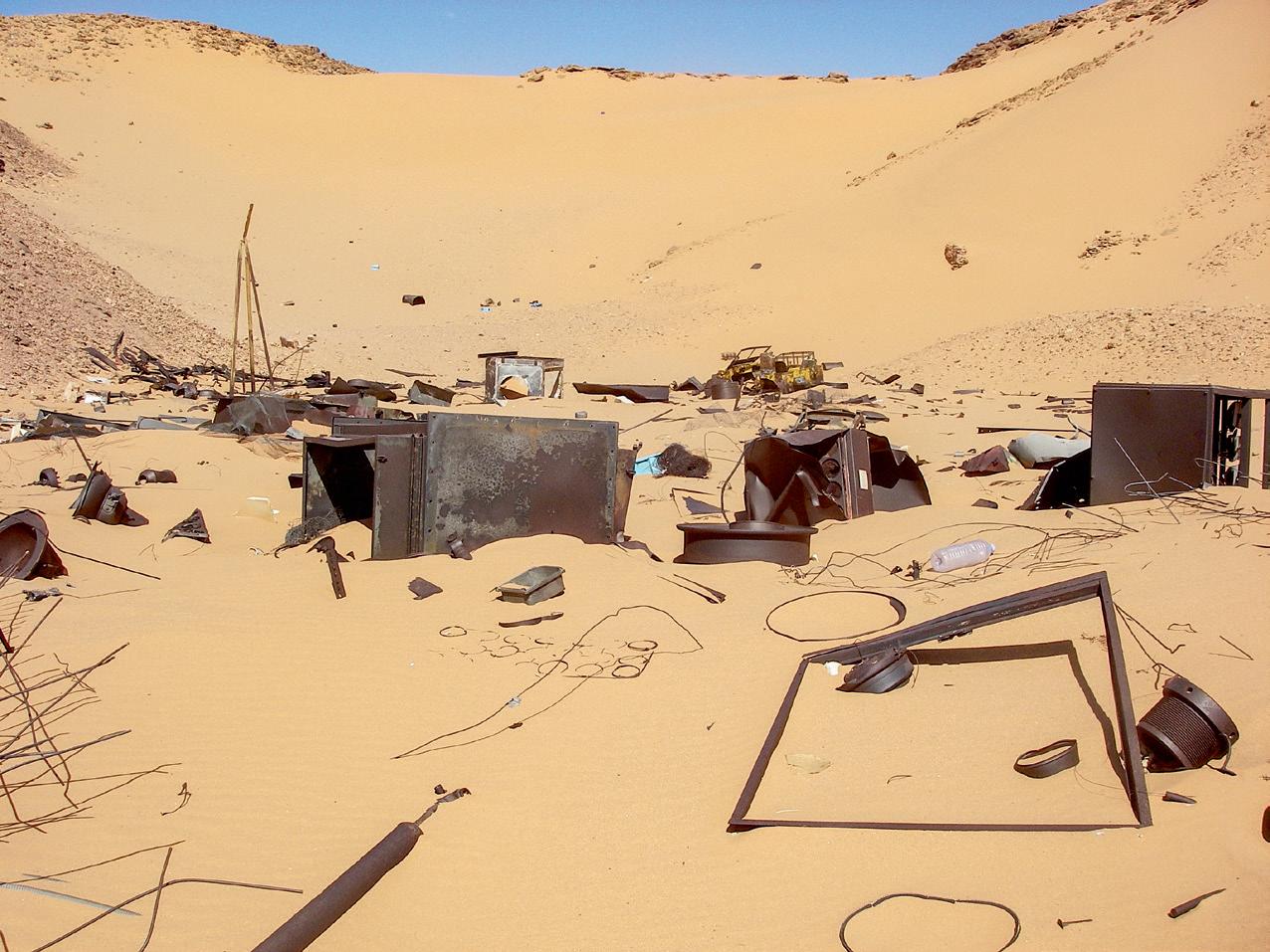
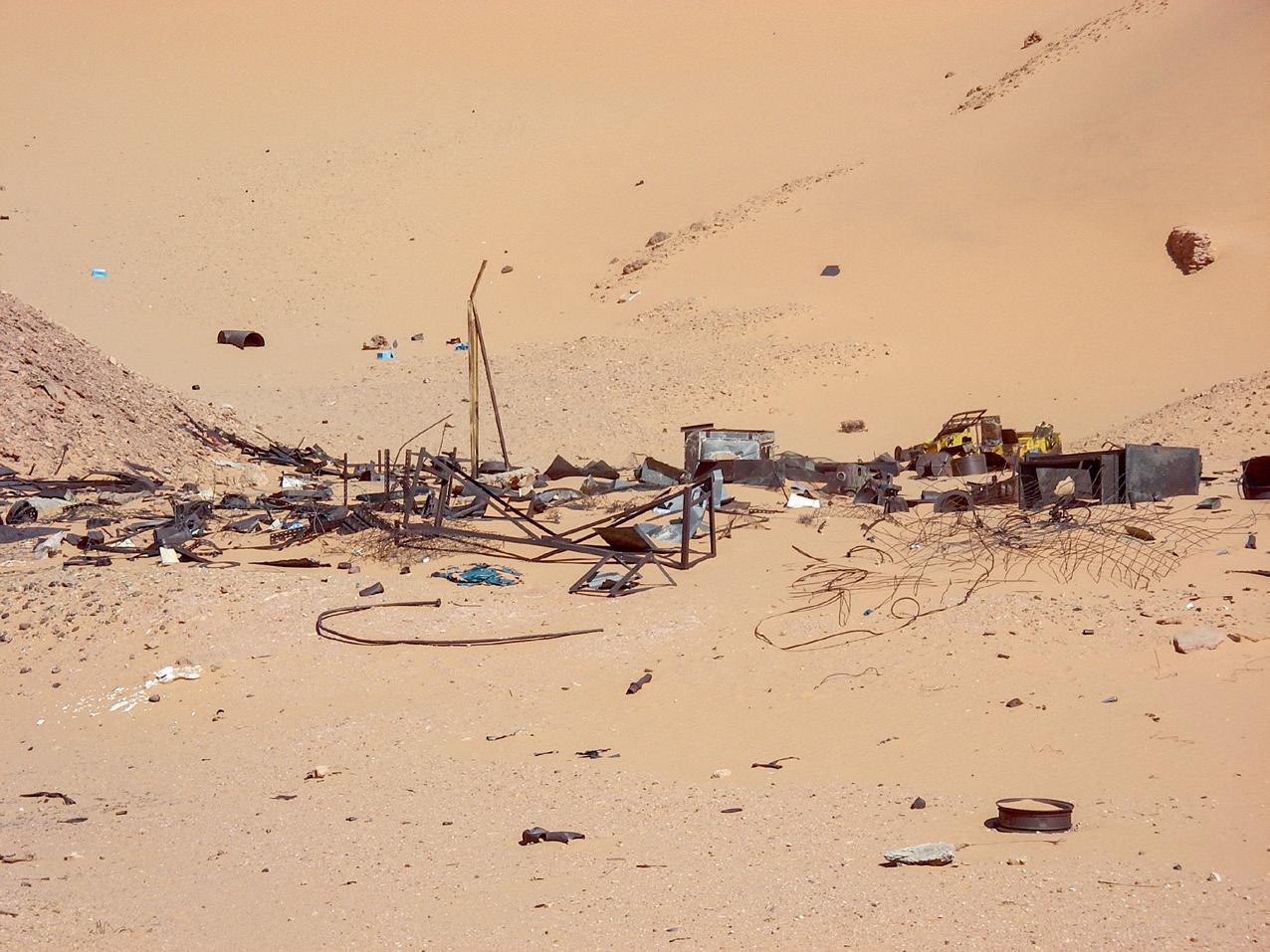

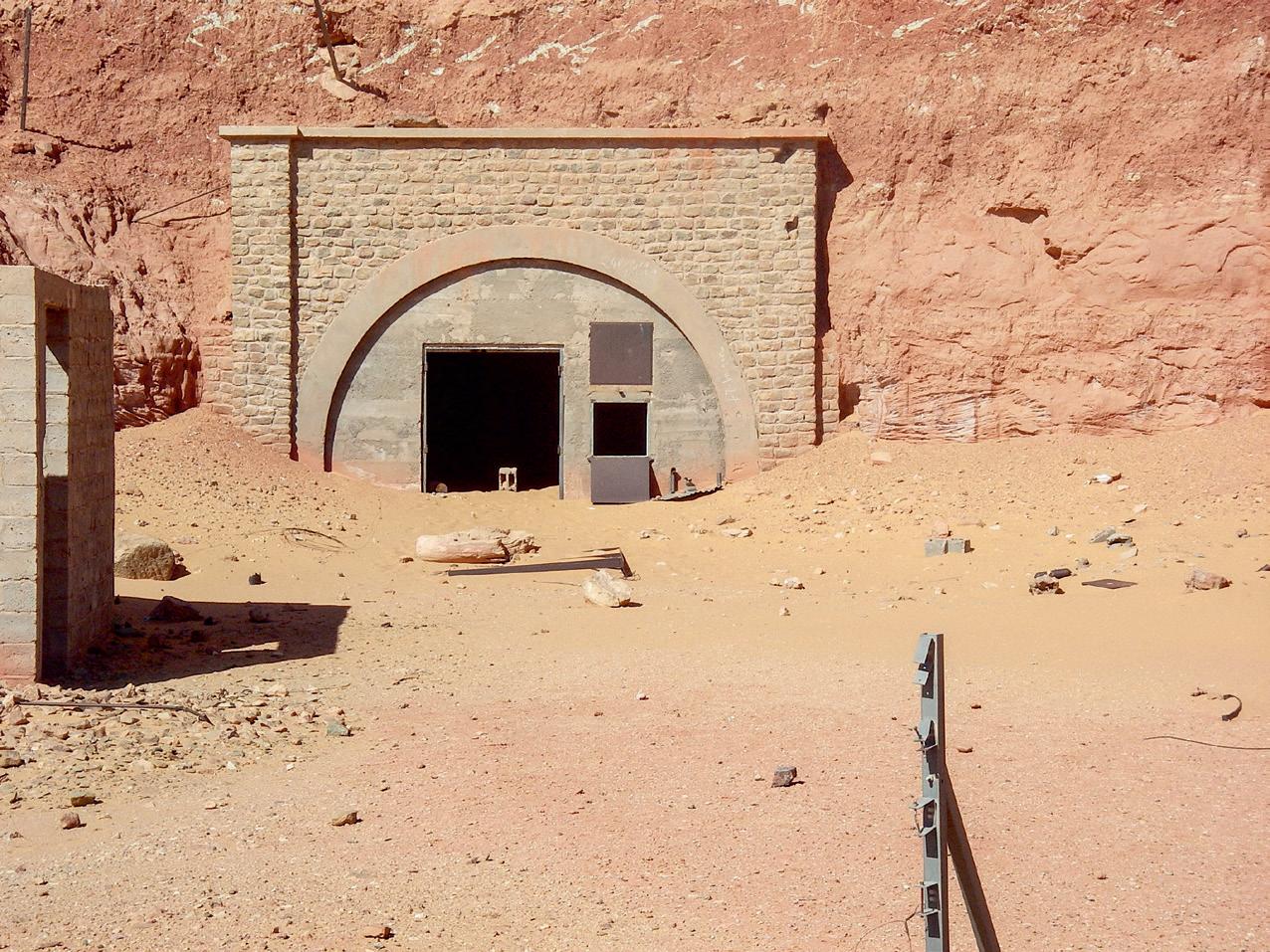
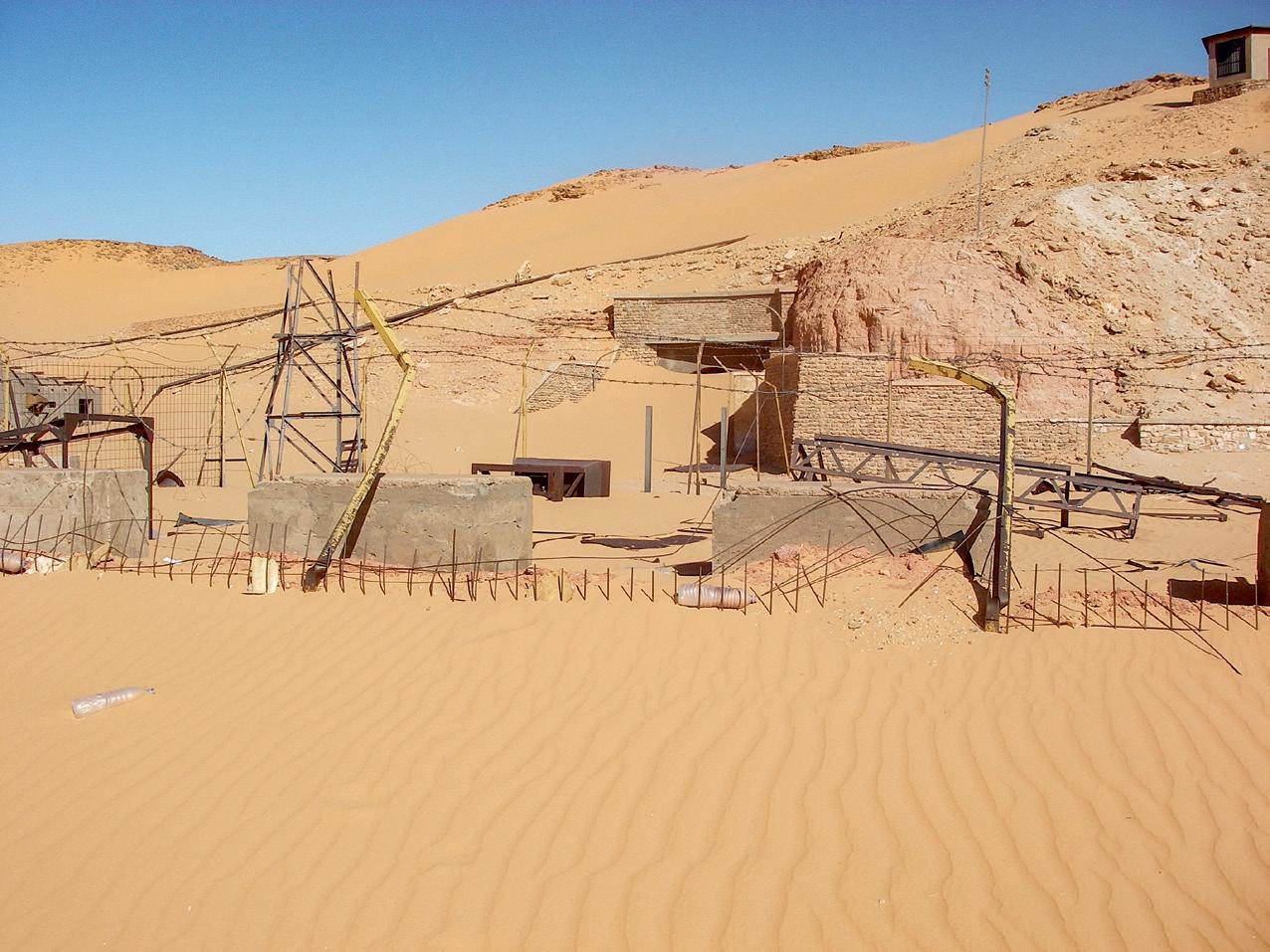

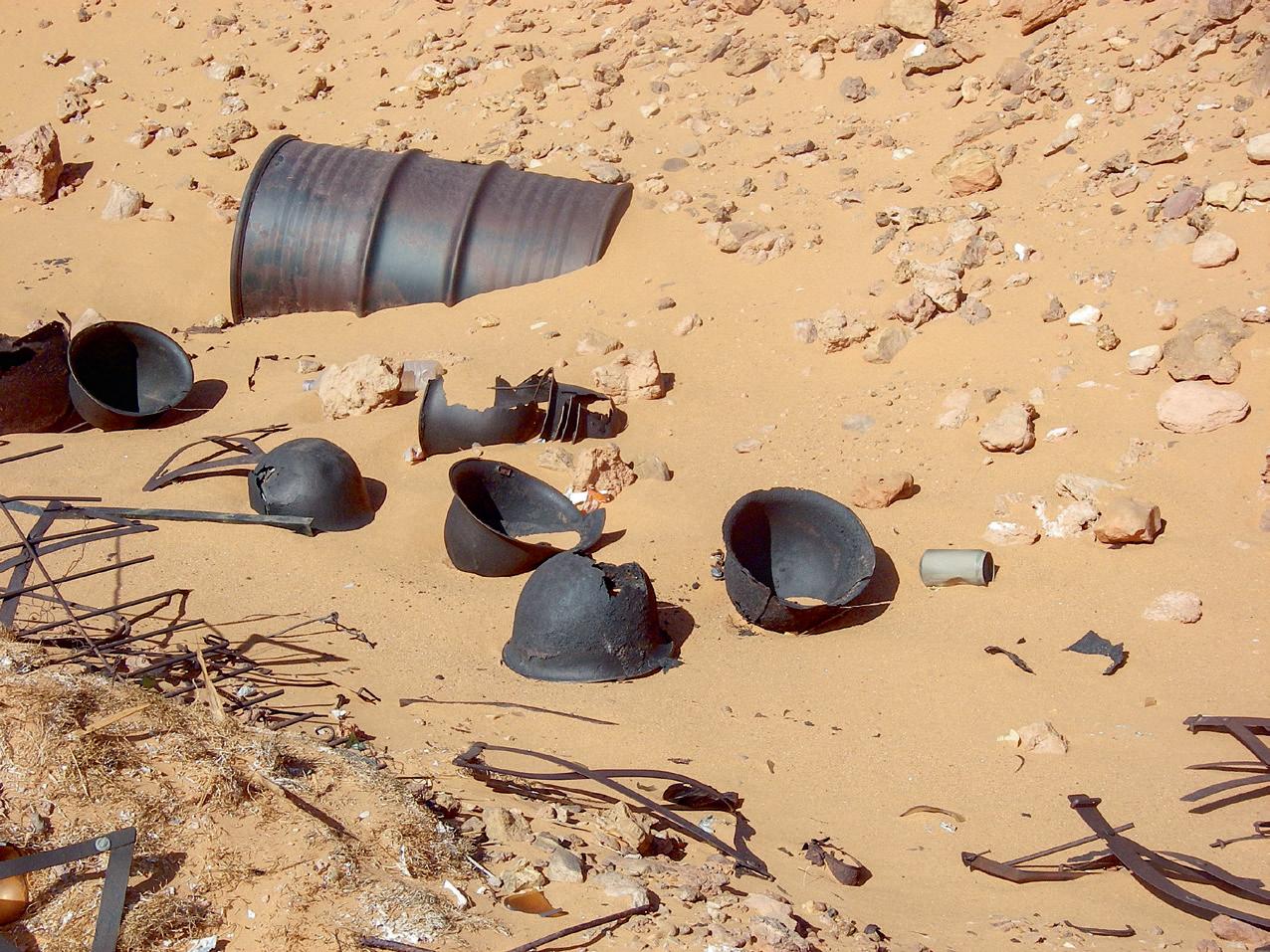
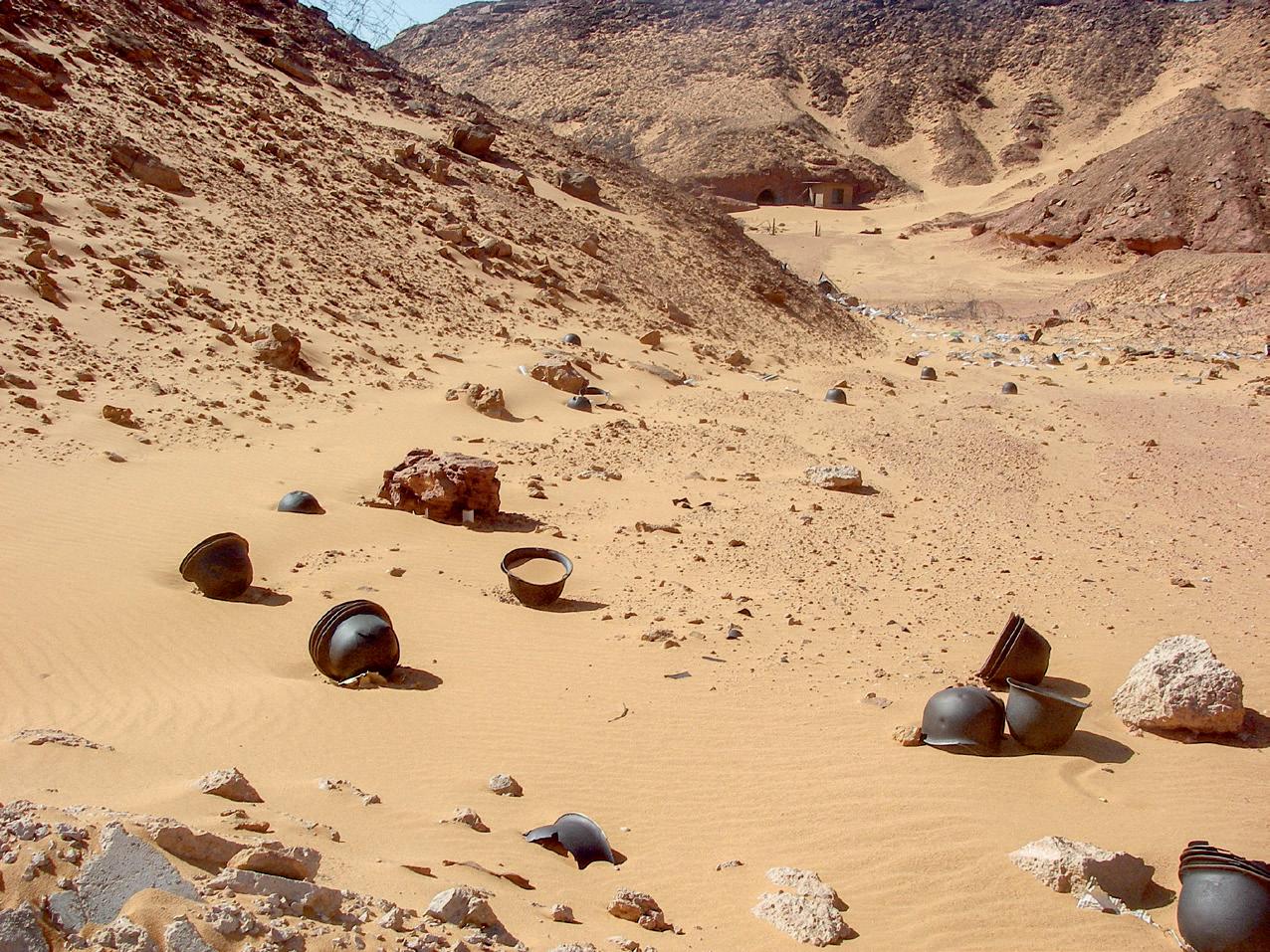
© 2022 by the Trustees of Columbia University in the City of New York All rights reserved.
No part of this book may be used or reproduced in a the context of reviews. Every reasonable attempt has been made to identify the owners of copyright. Errors or omissions will be corrected in subsequent editions.
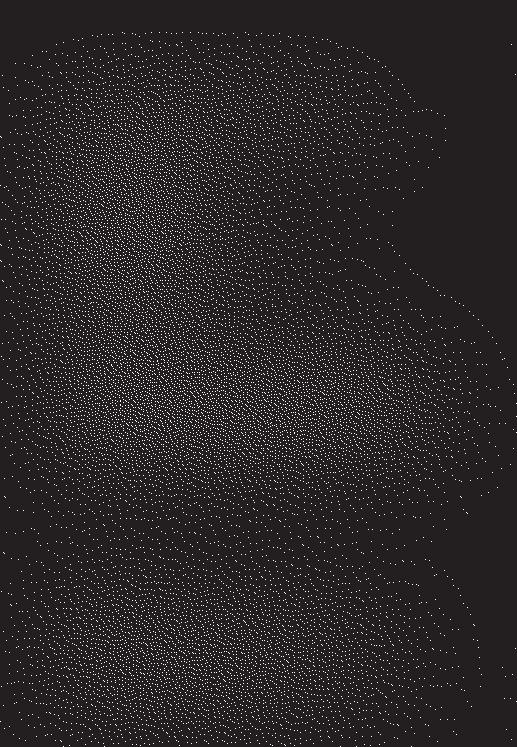
This book has been produced through the Office of the Dean, Amale Andraos, and the Office of Publications at Columbia University GSAPP.
This project was supported in part by the Preston Thomas Memorial Lecture Series Fund at the Department of Architecture, Cornell University.
